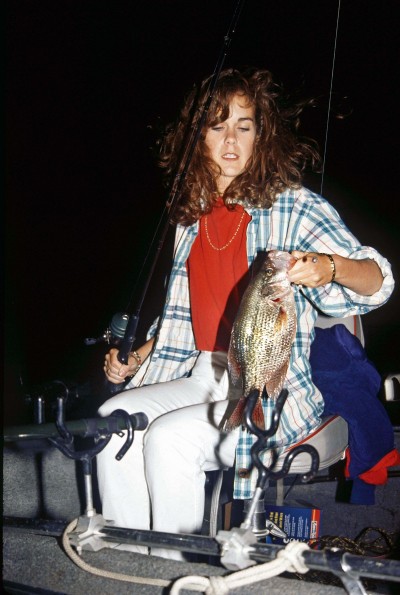Fishing Hot-weather Nights for Crappie
John E. Phillips 07.01.14

The thick, mushroom-shaped clouds on this muggy night allowed the moon only an occasional glimpse of our boat. Large swarms of gnats, mosquitoes, and sometimes a mayfly circled the white beam that the Coleman lantern cast into the dark water below. After fishing for three hours, we’d only caught two or three small crappie.
“Sometimes the papermouths don’t turn on until 1 to 3 a.m.,” a fishing buddy of mine explained. “But if and when the crappie start biting, we’ll take plenty of good-sized crappie—fast and furious.”
At 2:48 a.m., large numbers of slab-sized crappie schooled-up under the light. We caught the fish from two feet off the bottom to two inches from the surface of the 15-foot-deep water. Until the sun came up, the fishing continued non-stop.
What equipment you need
The biggest problem with fishing for crappie during the hot summer months is keeping your minnows alive and lively. I like an aerator that puts out bubbles in my minnow bucket. I fill plastic medicine bottles three-fourths of the way to the top with water, screw the lids tightly on the bottles, and put the bottles in the freezer. At one time, I’d put ice straight into my minnow water, but apparently some of the minerals in the ice killed the minnows. By using the iced medicine bottles and the aerator, I rarely lose any bait.

For a rod, I like either a lightweight B’n’M crappie rod or a Zebco ultralight rod. After putting a small weight on the end of the line, I then fish with a crappie rig that consists of two drop lines coming off a main line of four- to six-pound test. When I fish with a 10- or an 11-foot B’n’M graphite pole, I’ll rig with a crappie hook, a small-shot lead, and a quill cork, and set the cork on the outside edges of the light.
Many crappiers use lanterns, either floating lights that shine beams down deep toward the bottom or lanterns that draw in bugs and cause the bugs to fall into the water. Personally, I utilize both kinds of lights. I like to bait with live, large, shiner minnows and always carry at least a half-dozen 1/24- and 1/32-ounce jigs with me.
Where to fish
During the summer months, crappie will search for cool, highly-oxygenated water near structure. When the water temperature climbs, you’ll often find crappie on the edges of a river channel or a deep creek channel. Often you’ll locate crappie schooled up during the summer months on the point formed where a creek channel runs into a river channel, particularly if there are stumps and logs on it. Crappie move along these river and creek channels much like motorists travel interstate highways. These areas home the most baitfish, and the crappie will follow the bait.
Use a depth finder or a lake map to pinpoint the area’s underwater river and creek channels, drop-offs, and ledges. Bridges and railroad trestles that cross creeks, rivers, and lakes and their pilings usually effectively concentrate nighttime crappie. Crappie will hold on the down-current side of pilings in slack water and then move out into the current to feed. In addition, the pilings offer vertical structure, which allows the crappie to position themselves close to cover in the segment of water with the most-comfortable temperature as well as the most dissolved oxygen.
How crappie position themselves at night
“Often crappie will be holding right on the edge of a break near the bottom,” one fishing buddy told me. “As the baitfish concentrate under the light closer to the surface, the crappie will move up in the water, swim into the light and take the bait just under the surface. That’s why I drop my line all the way to the bottom and then count each turn of the reel off the bottom until I get a bite. The crappie usually will hold at one spot for some time.”
Different schools of crappie may move under the lights at various times of the night, meaning you may fish for three hours without ever getting a bite and then start catching crappie on every rod as fast as you can get baits in the water. Crappie fishing at night in the summertime doesn’t interfere with any of my daytime activities. I can fish in the afternoon after work or all night Friday and Saturday or all day on Saturday.
I must warn you. I don’t know of a more addictive form of fishing than hunting for nighttime crappie. Cooler, relaxing, and rewarding fishing is an ideal way to spend quality time with friends and family away from the rest of the world. Crappie fishing at night has it all.
Be sure to check with your conservation officer to learn what the regulations are for night fishing on the lakes you plan to fish.
For information on crappie fishing, click here to see John E. Phillips’ Kindle eBooks and print books on crappie.

